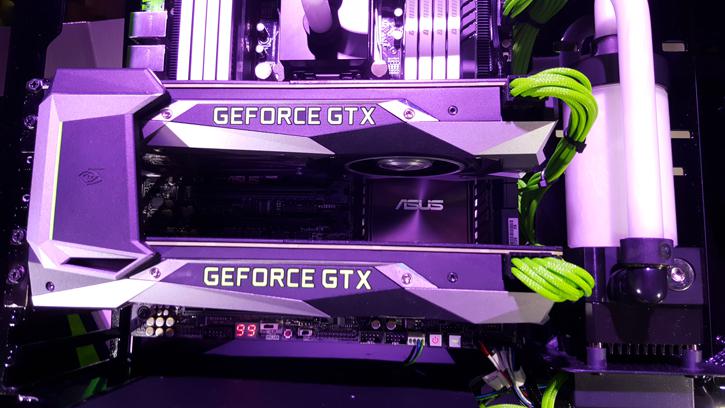With the announcement of the GeForce GTX 1070 & 1080 Nvidia also launched a couple of new technologies, a new way of making screenshots, VR Audio, Improved multi-monitor support and SLI, in this items I wanted to run through them.
Nvidia Ansel: 360 Degree Screenshots
Named after a famous photographer Nvidia intros Ansel, a new way of making in-game screenshots. Capturing stills from games we pretty much do on a daily basis here at Guru3D. With the Ansel announcement Nvidia steps it up a notch, Nvidia even called it an Artform (I wouldn't go that far though). Screenshots typically are based on a 2D image taken from a 3D rendered scene. Nvidia figures (with VR in mind) why not grab a 360 screenshot in-game (if the game supports Ansel technology) so that you can grab a still, save it and then later on use your VR headset to look at the screenshot in 3D. it can also be used to create super-resolution screenshots or just 'regular' screenshots and then apply EXR effects and filters.
Ansel offers the ability to grab screenhots in 3D at incredible resolutions, up-to 61.440 x 34.560 pixels with silly sized screengrabs that can be 1.5GB for one grab. Funky however is that Nvidia 'borrowed' some SweetFX ideas. After you captured the screenshot you can alter the RAW data and this make an image darker/lighter, set color tone and thus apply filters at that screenshot (Think instagram effects). While not 'necessary', Ansel was design with VR in mind so that you can grab a still and then alter it and then watch it in 3D with your Oculus Rift or HTC Vive. Ansel will also become available for previous generation products and is not a Pascal specific thing.
Ansel does need game support, some titles that are and will support it: Tom Clancy's The Division, The Witness, Law Breakers, The Witcher Wild Hunt, Paragon, No Man's Sky and Unreal Tournament will be the first adopter games to offer support for this new way of grabbing screenshots.
VR Audio
Another technology that was introduced is again VR related. Nvidia offers VRWorks, a set of developer tools that allows the devs to improve their games with VR. One of the new additions is VRWorks Audio, this techology makes it possible to simulate GPU reflections and absorption of audio waves within a virtual 3D-space. Basically the GPU will calculate and predict how certain audio would sound if it bounces of a hard floor or a soft one combined with other objects it bounces off. Example, if you talk in a room with concrete walls it would sounds different opposed to that same room with carpets hanging on the walls. The last time that a GPU manufacturers added 3D audio over the GPU it failed to become a success alright, that would be AMD True Audio.
The question arises, will VRWorks audio create enough interest and momentum so that developers will actually implement it ? To demo all the possibilities of VRWorks Nvidia will release a new demo-application soon, it is called Nvidia VR Funhouse. The application will not just demo VRWorks Audio but also Physics simulations in a VR environment.
SMP - Simultaneous Multi-Projection
One of the more interesting and bigger new technologies demoed at the GeForce GTX Series 1000 Pascal launch was Simultaneous Multi-Projection, which is pretty brilliant for people using three monitors. You know it, when you place your right and left monitor at an angle, the game will get warped looks as the angle does not match. See the screengrab below:
Look at the angle related bends when you place your surround monitors in an angle.
New with Pascal is simultaneous multi-projection, a technology that allows the GPU to calculate a maximum of sixteen camera view points, at nearly no performance loss. Previous gen GPU-architectures can only do the math on one came viewing angle / point of views. This features is not software based, it is located in hardware in the GPU pipeline.
So why would you want to be able to do this you might wonder ? Well, I spilled the beans already a bit in the starting paragraph. Currently when you game on multiple screens you are looking at a 'Projection' of one 2D image. Now if you have one 2D Image on three monitors, then it's only going to look good if the monitors are standing in straight line next to each other. When you angle of 'curve' the monitors around you the angles will distort the image, e.g. a straight line would have a bend. Some games have fixes for this, but nothing solid. Well, with Pascal this is a thing of the past as this is exactly where Simultaneous Multi-Projection comes in. With the help of your driver control panel you can alter the angle of your monitors that matches how you have setup the monitors. The 3D imagery will now be calculated for each screen on the GPU based on the angle of your monitors. So if you would surround yourself with three monitors, the rendered images displayed will not be warped, but will be displayed correct.
Have a look at the screengrab again, now with Simultaneous Multi-Projection enabled.
The beauty here is that due to the added core-logic on the GPU, this angle correction does not come at a performance loss, or at least a very little one. SMP obviously also helps out in VR environments where typically you need to do all kinds of tricks for the normally two rendered images versus lenses and warping. To be able to do this in one pass in hardware on the GPU will create huge performance increases for the upcoming GeForce GTX 1070 and 1080 on VR. Again, this is hardware based and thus cannot be added to Fermi and or Maxwell models with a driver update.







